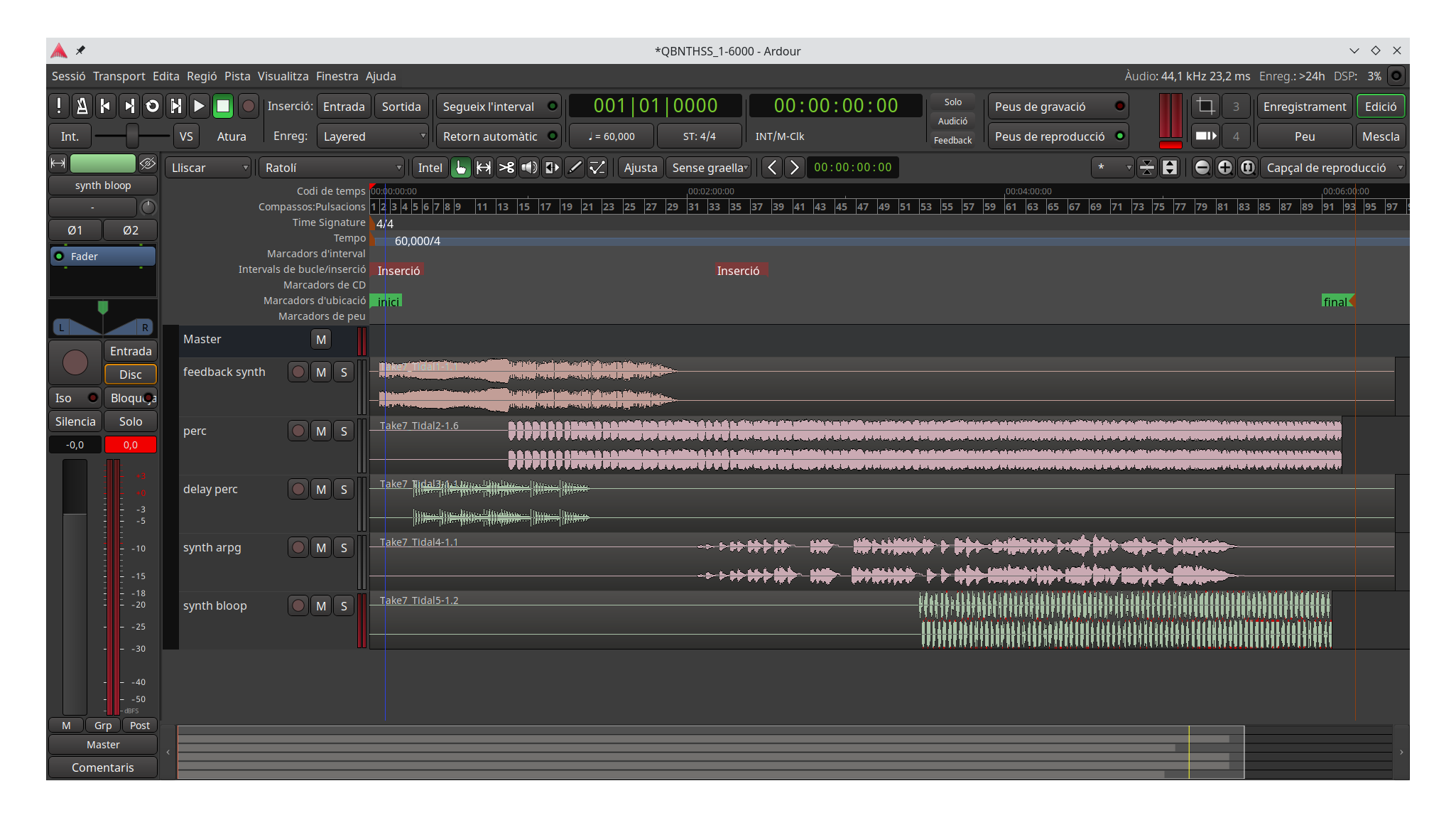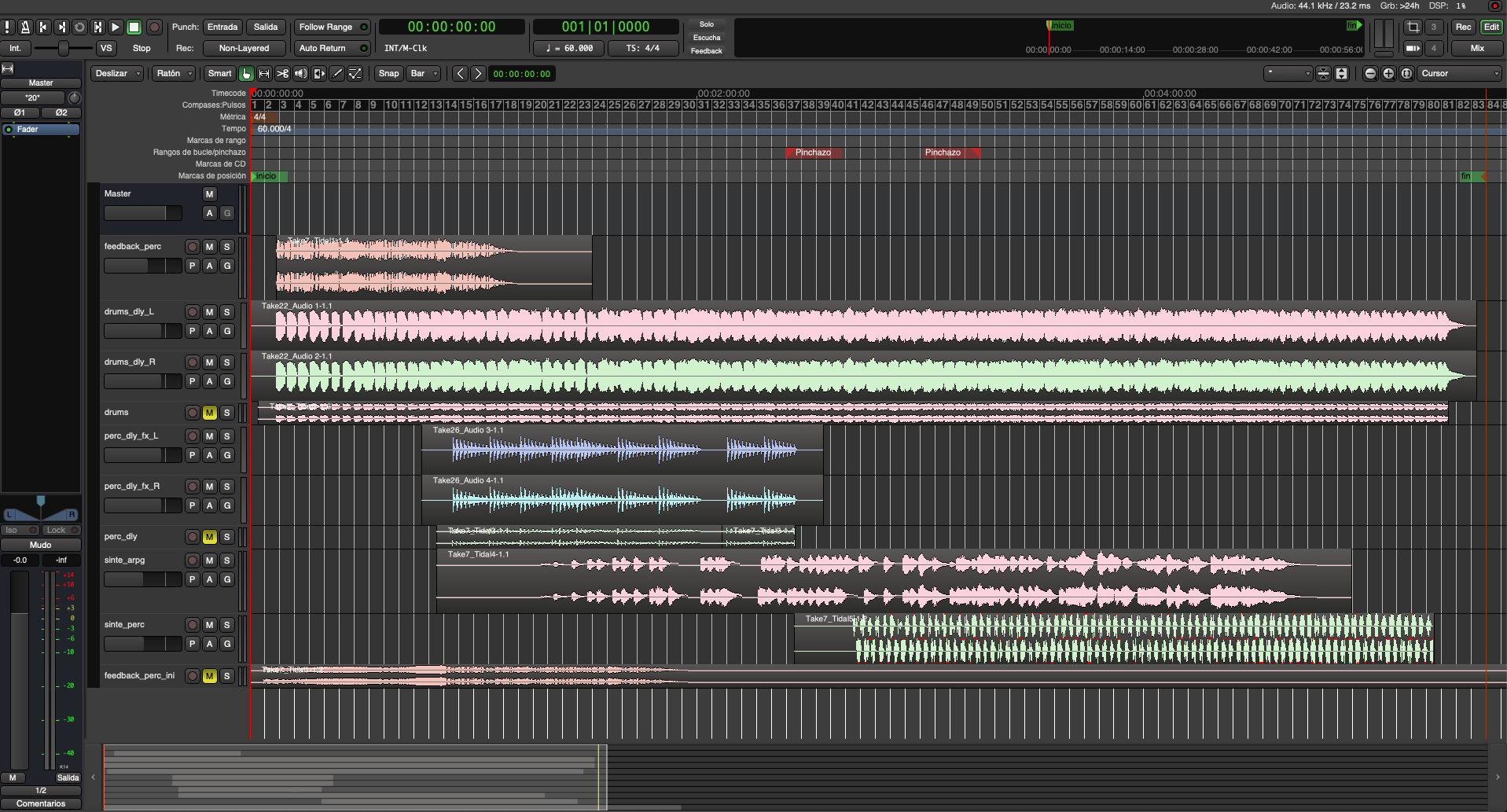| Tidal musician | Ramon Casamajó |
|---|---|
| aka | QBRNTHSS |
| Location | Barcelona (Sp) |
| Album/Release | The Magic Words Are Squeamish Ossifrage |
| Genre | Glitch/Noise, Electronic, Experimental |
| Available | Interworld Media - Bandcamp |
| Release date | 21/04/2023 |
Summary
My name is Ramon Casamajó - aka QBRNTHSS (pronounced “quebrantahuesos”, meaning “bearded vulture” in Spanish). QBRNTHSS is the alias I use for my solo works focused on electronics. This post covers the live coding, mixing and recording process I used in my album, recently released through Interworld Media on Bandcamp.
The album title - The Magic Words Are Squeamish Ossifrage is the plain text solution to many cryptographic challenges, a tradition originated in a challenge set by the authors of the RSA encryption algorithm in 1977. It is my first full-length album as QBRNTHSS, the result of more than a year of live performances and rehearsals using Tidal Cycles and Supercollider as main instruments. It’s published on the Sheffield label Interworld Media in digital download and cassette tape, and aesthetically it’s a mixture of synthetic textures, noisy ambients and broken rhythms.
I’m going to explain the recording process used for the whole album - except one track that was recorded previously without live coding, but I feel it fits in perfectly...I bet you can't guess what track it is :-)
Hardware and software used
The album was recorded and mixed in different locations with this hardware and software equipment:
- Lenovo ThinkPad T14 with Manjaro Linux
- Focusrite Scarlett 2i4
- Effects pedals: Boss DD-7 digital delay, TC Electronic Hall of Fame 2, Meris Ottobit Jr., Boss Metal Zone 2
- Korg Nanokontrol 2 midi controller
- Cadence (JACK)
- Carla plugin host
- VST synthesizers: Odin 2, Helm, Yoshimi
- Supercollider
- Tidal Cycles
- Ardour (DAW)
As sound sources I used some samples that I’ve been collecting for a while (specially the percussion ones), some other samples that I have recorded by myself, and Supercollider synths made by the community and a few ones by myself.
After the recording and mixing process the album was mastered by Alfonso EVEL at EVEL Records.
Recording process
The record is the culmination of about a year performing and rehearsing. At some point I had a bunch of good ideas (at least that’s my impression), and the motivation to make a new album. But I didn't want to just record what I was doing live, my goal wasn’t to document my live practice. I wanted to do an album that was interesting and enjoyable for itself, an album that I would buy myself and listen to at home.
From the beginning my conception of the album was to be a collection of short or concrete sound passages, the previous ideas went in this direction too. I didn’t want to record long soundscapes that evolve slowly over many minutes, which I love too, but that wasn't the point here.
Also some time before the recording I had started to use some effects pedals to process the sound and make the live performances more dynamic and fun, so I wanted to use them on the album.
I decided to record on multiple tracks on the DAW (Ardour), and in more than one take when it was necessary. That allows me to:
- Polish the mix in the daw.
- Apply more controlled dynamic changes from Tidal Cycles than if I had to record in one single take. I could focus on some parts of the song one after another.
- Process some parts separately with the effects pedals afterwards.
That said, I didn’t record every sound in a separate track, just what I needed to let me construct the song comfortably. On the other hand I didn’t do overdubs once a track was recorded, only little edits sometimes.
So basically the record process for a song went like this:
- Play and record the different tracks from Tidal Cycles to Ardour.
- In Ardour adjust the mix and do some edits if necessary.
- With an effects loop record again some tracks through the effects pedals, applying as I like it.
- Finalize the mix with the final touches: adjusting volumes, final edits (some fade-ins or fade-outs, cutting some starting or ending parts, etc), and do some stereo panning in some tracks.
Code
As an example, here is the code and DAW screenshots for the second song on the album, entitled Bone:
setcps (60/60)
-- sustain loop
d1
$ trigger 1
$ s "snoisefb*5" # n "<b5'min7>"
# voice 1
# sustain (rangex 0.025 0.9 $ slow 100 $ tri)
# lock 1 # delay 0.2 # delayt 0.1 # delayfb 0.2
# accelerate 1 # speed 3
# pitch1 (range 0.02 0.1 $ slow 27 $ sine)
# resonance 2.5 # gain 0.75
# octer 1
do
let pats =
[
("pl", s "HIHATS:6*4" # n ((irand 5)+10) # sustain 0.5),
("cr", s "KORGER1*4" # n ((irand 4)+29) # sustain 0.1),
("cl", s "~ claps ~ claps ~" # n ((irand 5)+2)),
("bb", s "[BASEDRUMS:22*4, BASEDRUMS:41*4]"),
("bs", s "BASEDRUMS" # gain 0.96 # n (choose [9,14,17,19,29,33])),
("sl", s "~")
]
d2 $ fast 2 $ ur 6 "[{pl} sl bb]" pats[]
d1
$ stb 0.3 (fast 2)
$ s "snoisefb*5" # n "<b5'min7>"
# voice 1 # sustain 0.025
# lock 1 # dly 0.2 0.1 0.2
# accelerate 1 # speed 3
# pitch1 (rgs 0.01 0.1 12)
# resonance 2.5 # gain 0.75
# octer 1
d3
$ trigger 3
$ slow 11
$ s "wndelayfb" # n "c"
# gain 0.9
xfadeIn 4 30
$ slow 10
$ off 0.01 (# fshift ((cF 0 "23")*220))
$ stb 0.3 (stutter 3 (1/32))
$ degradeBy 0.4
$ stb 0.4 (jux rev)
$ n (scramble 3 (arpg "<a5'min7>")) -- ff5'min9 d6'sus4
# s "sawdelayfb"
-- # pan rand
# sustain 5 # gain 0.9 # orbit 3
d5
$ n "c3" # s "fu"
-- # octave ((irand 5)+3)
# reps (((cF 0 "21")*3)+2)
# ftime (cF 0 "22")
# pan (rgs 0 1 2)
# gain 0.9
# lpf 1250
xfadeIn 1 19 sil -- fb
xfadeIn 2 20 silence -- beats
d3 sil -- perc dly
xfadeIn 4 20 silence -- arpg
xfadeIn 5 20 silence
DAW - Ardour
The Ardour screenshot reflects the status after the first recording step. This is what I’ve recorded in every daw track:
- d1 -> feedback synth
- d2 -> perc
- d3 -> delay perc
- d4 -> synth arpg
- d5 -> synth bloop

Next, the Ardour screenshot shows the status after the effects loop recording step, where some edits and extra tracks with the effects pedals were applied:
- I changed the beginning of the song discarding the first part of the “feedback synth” track (you can see the final track as “feedback perc” and the original “feedback_perc_ini” muted).
- I used the Boss delay pedal to add some dub flavor to the original track "perc", resulting in “drums_dly” left and right (see the original track as “drums” muted).
- I used the TC Electronic pedal to add some reverb to the original “delay perc” track, resulting in “perc_delay_fx” left and right (see the original track as “perc_dly” muted).

So that’s it. Hope that this post is interesting and that you can listen to The Magic Words Are Squeamish Ossifrage. Working on it was a challenge that I have enjoyed a lot, and I love the results… I think that finally I will buy the album!
More info
For next gigs and more info you can follow me at: